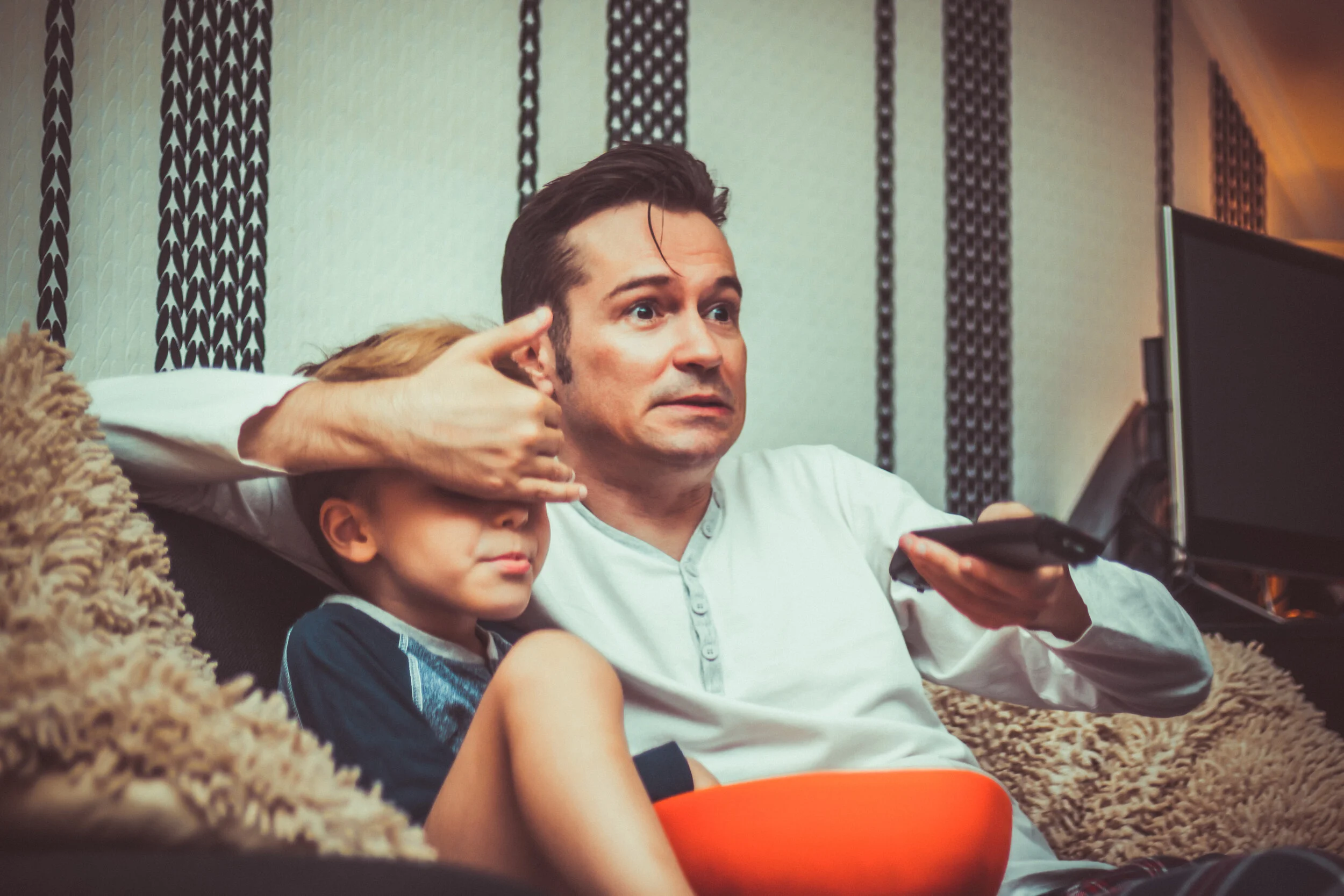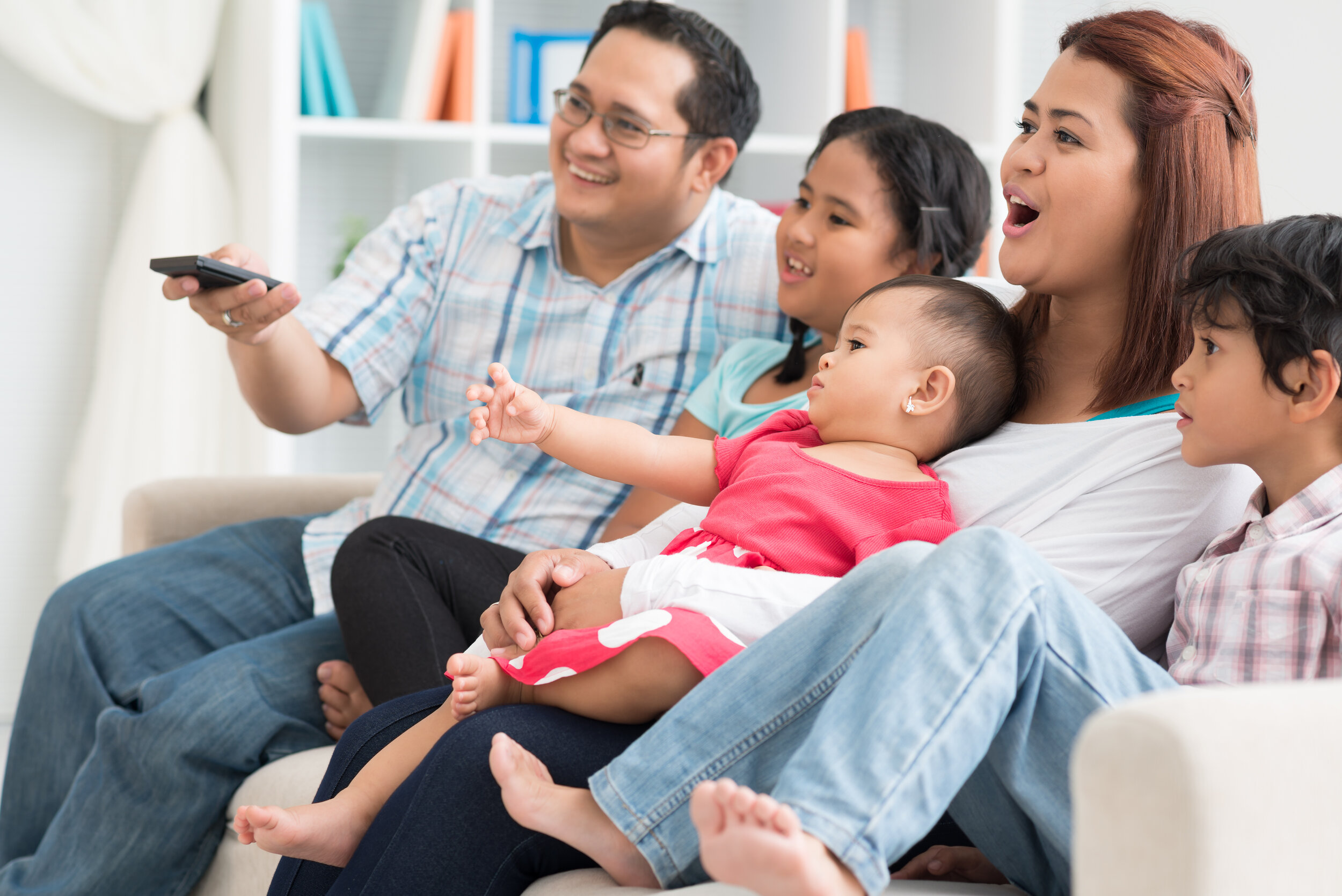
Setting Screen
Limits
“If you piss off your kids, then you are doing your job. ”
It is our responsibility as parents to teach our children how to use tech well and in equilibrium with other important uses of their time. We’ve curated suggested tactics from mental health experts, media experts, and everyday parents doing the hard work of managing and mentoring their families’ tech-life balance. There are many ways to manage screen time so take what makes sense to you.
Top Tips
Steer your child towards good content.
Ensure screen time doesn’t replace other essential activities.
Set limits on where and when your child uses tech.
Be flexible, curious, and communicative as you find your way on this journey.
Why set limits?
Technology can be sticky and designed to keep our attention so it’s hard for us to put down our devices.
Young people’s brains are developing until age 25 and brain development is impacted by how kids spend their time, both online and offline.
Screen time can displace activities that are essential to healthy human development - e.g., sleeping, being outdoors, physical activity, and feeling deeply connected to family and friends.
** Want to see alarming research findings? Explore the Center for Humane Tech’s Ledger of Harms and NYU research lab findings led by Jonathan Haidt, author of The Anxious Generation.
Tip 1: Steer your child towards good content.
How kids spend their time online can have a big impact on them both positively and negatively. Help them find tech that supports their interests and your family values while avoiding the junk and noisy distractions that are also readily available. A bit of due diligence up front pays off in the long run. Your child will bring their own ideas to you, as well; when that happens you can use our 4-step process for considering new apps and games.
“Pick any media exposure as carefully as you would pick a babysitter.”
Which digital media would you like your child to have access to?
Consider our PreK-8 suggestions by age-group below.
Preschool
Ok Solo
Slower paced shows hand-picked by a parent like Mr. Rogers, Daniel Tiger’s Neighborhood, Sesame Street, Blue’s Clues, Dora the Explorer, and Wild Kratts.
- Check Common Sense Media for recommendations by age or theme, or you can look up a specific show for its review and age rating.
- See Fairplay’s checklist for picking video content for young children.
OK with Parental Controls
Video chatting to connect with approved family and friends.
- Check out Caribu for a reimagined and age-appropriate way for your child to video chat with friends and family!
Not Yet or Closely Supervised
- Video games
- YouTube
- Social media
- Internet
- App Store
If your preschooler uses apps, see Fairplay’s checklist for picking preschool apps.
Elementary School
Ok Solo
Video chatting to connect with family and friends.
- Check out Caribu for a reimagined and age-appropriate way for your child to video chat with friends and family!
Parent-approved shows: Check Common Sense Media for recommendations by age or theme. Documentaries available on CuriosityStream. - Recommended streaming services include PBS Kids, Sensical, Kidoodle, and HappyKids.
Parent-approved video games: Find age-appropriate game lists at Common Sense Media and see this video game industry veteran dad’s guide to video games.
Parent-approved products and apps that provide a good use of tech. Ideas: Tinkercad and Thingiverse for 3D design, Scratch for coding, Google Docs and Sheets, Duolingo for learning a language, Khan Academy for academic topics, Koma Koma for stop motion animation, Pic Collage for making digital photo collages, GarageBand for creating music, iMovie for creating films, Procreate for iPad drawing. With your child, consider new apps they want using our 4-step process.
OK with Parental Controls
Internet searching
YouTube specific channels to cultivate interests (Common Sense Media rates YouTube channels)
Not Yet or Closely Supervised
- App store
- Social media
Common Sense Media recommends you wait until your child is at least age 15 for TikTok and Instagram and age 16 for Snapchat.
Middle School
Ok Solo
Video chatting to connect with family and friends
Parent-approved shows: Check Common Sense Media for recommendations by age or theme. Documentaries available on CuriosityStream.
Parent-approved video games: Find age-appropriate game lists at Common Sense Media and see this video game industry veteran dad’s guide to video games.
Parent-approved products and apps that provide a good use of tech. Ideas: Adobe Illustrator for design work, Tinkercad and Thingiverse for 3D design, Scratch for coding, Google Docs and Sheets, Duolingo for learning a language, Khan Academy for academic topics, Koma Koma for stop motion animation, Pic Collage for making digital photo collages, GarageBand for creating music, iMovie for creating films, Procreate for iPad drawing. Teach your child how to consider new apps they want using our 4-step process.
OK with Parental Controls
- YouTube (Common Sense Media rates YouTube channels)
- App store
- Internet searching
Not Yet or Closely Supervised
Social Media
Common Sense Media recommends you wait until your child is at least age 15 for TikTok and Instagram and age 16 for Snapchat.
Need inspiration or affirmation?
Why Social Media is not smart for middle school kids
No social media until high school #WaitingIsLoving
If you still decide to introduce social media, check out Wait Until 8th’s Social Media Guide.
Tip 2: Ensure screen time doesn’t replace other essential activities.
Make a plan for prioritizing activities you value on a daily or weekly basis. Family therapist, Polly Ely, suggests picking 4-5 activities your child needs to do on a regular basis before they have access to screens - i.e., those activities you most value because the reality is that what we do in a day is what makes up our life!
A strategic approach here is to get your child excited to “turn on” life’s vibrant activities (like exploring nature), rather than upset to “turn off” screens. Sometimes screen time defaults are just unintended habits, so help your child mix up their daily routine — redirect them to other activities and create new habits! A brilliant resource for simple unplugged activities is What Do We Do All Day.
Set yourself up for success by brainstorming what supplies your child might need to pursue other activities and interests. At first, expect several rounds of pushback while your child learns (or re-learns) how to settle into something else. Hold firm and you’ll get through the transition!
“Play is the work of childhood.”
Which childhood activities do you value more than leisure screen time?
1. Being outdoors — ideally in nature — for at least one hour per day
Find inspiration from 1,000 Hours Outside where you can download tracking sheets, and gather ideas for outdoor activities from Run Wild My Child. Get affirmation from Dr. Mathew White’s research showing that spending a minimum of two hours in nature per week benefits human health and wellbeing. See more nature research findings here.
2. Moving their body for at least one hour/day
3. Completing chores - e.g., washing dishes, making their bed, taking out the garbage, helping with laundry, tidying their bedroom and toys, caring for a pet, making their own school lunch. These help develop independence and accountability. Check out our newsletter issue on increasing chores at home.
4. Reading for 30 minutes minimum per day - find affirmation here. Inspiring book ideas can be found here.
5. Completing daily self-care routines like brushing their teeth, getting dressed, etc.
6. Playing without structure or the direction of adults or technology for at least one hour - e.g., making art, building with their hands, developing a hobby, practicing music, creatively free-playing, learning how to be alone with their thoughts.
This will help them learn how to overcome boredom, generate their own ideas, develop the muscle of “being alone” without feeling lonely, and problem-solve their way to something they like without a screen.
Experts believe children are partly drawn to screens because they are unsupervised contexts.
7. Completing school work / homework — which may be on a screen, but that’s mandatory
8. Making sure they’re on track for their regular bedtime of [Xpm] to protect their sleep. The CDC summarizes daily sleep needs by age here.
9. Playing/connecting socially with a sibling, neighbor, friend, etc.
10. Spending time as a family. Your home is your lab for social-emotional development so you want to preserve some time together to develop meaningful connections.
“When we hand our children phones we steal their boredom from them… As a result, we are raising a generation of writers who will never start writing, artists who will never start doodling, chefs who will never make a mess of the kitchen, athletes who will never kick a ball against a wall, musicians who will never pick up their aunt’s guitar and start strumming.”
Tip 3: Set limits on where and when your child can use tech.
While we love tech, it’s so ubiquitous, sticky, and is designed to endlessly demand our attention. We need to teach our kids self-awareness of their habits and to keep tech in check. Our goal is to coach our kids to enjoy tech as an amazing tool, but not to overuse it or let it take over their daily life. With that in mind, we need to work hard to keep times and places device-free, preserving sacred spaces for connecting as a family and focusing on other interests.
Which tech limits and boundaries resonate with your family?
a) When can your child enjoy leisure screen time?
Want to set a daily time limit? E.g., leisure screen time is allowed for up to [30] minutes per weekday and [1 hour] per weekend. All other times of day are reserved for other activities like reading, playing outside, and dealing with boredom.
Want to define certain times of the day when screen time is allowed? E.g., allotted screen time can happen anytime between 4-7pm; or when parents are busy cooking dinner; or on weekend mornings after 8am while parents sleep in; or when a parent is available to co-watch.
Want to have prerequisites for screen time? E.g., screens are only allowed AFTER completing homework, going outdoors for an hour, freeplaying for an hour, and doing chores.
Want no regular screen time? E.g., screens are only enjoyed during a family movie night or for specific purposes to have some exposure but not as part of the daily routine.
b) Where can your child enjoy leisure screen time?
Only at home? I.e., no mobile access to certain devices or apps.
At home in a central living area? With parent supervision required and no wandering off with devices.
Any exceptions for specific purposes? E.g., doing homework.
In their bedroom? If you allow your child to use a device in their bedroom, it’s best practice to have them keep their bedroom door open, use their device according to family rules and limits, and charge it outside their bedroom overnight. Gaming consoles are best kept in a common area - see more tips from a veteran dad in the gaming industry.
c) During which scenarios should your child’s device be stowed?
In the evening after 9pm (or one hour before bedtime)? This protects sleep and preserves time for book reading. Phones and other devices should be charged overnight outside of bedrooms in a designated area.
In the morning until 8am? This protects sleep and gives them time for an unplugged morning routine.
Before school? This gives them time for their own thoughts and emotions rather than those of others before heading out for the day.
When having a family meal together? This promotes family time, conversation, and manners without interruption.
During playdates or when hanging out with friends? Except when agreed upon for specific purposes? So screens don’t disrupt face-to-face socializing.
When at a store? To engage with that learning environment.
When at a restaurant? To practice patience, manners, and conversation. Bring a tote bag with screen-free supplies to occupy younger children.
When having family time at home or elsewhere? To be present and make precious time together as uninterruptible as possible.
When on vacation? Because it’s good to practice unplugging from time to time, and vacation is an ideal time to deeply connect and explore new places.
When in the car? Because cars offer a unique side-by-side context that often fosters conversation, and is an opportunity to zone out/deal with being bored/self-soothe. With exceptions for long roadtrips!
When in a carpool with kids from different families? To encourage presence and in-person socializing during school field trips, transport to sports, and the like.
When out and about around town? At a park? At friends’ houses? At sports or other activities? So devices don’t detract from child’s play and socializing.
During the in-between transition times of the day when IRL conversation is a better alternative? E.g., walking to/from a sports field or while waiting for class to begin. Easy access to devices erodes these opportunities to start a conversation and cultivate a new friendship.
When facing tough emotions or having a tantrum? Regularly turning to a device during challenging times misses the opportunity for kids to develop self-soothing skills and resilience.
When the device isn’t directly supporting an activity your child is pursuing? So it doesn’t interrupt down time, free time, hobby time, music time, reading time, basketball time, homework time, etc.
We want our children to view their phones as separate from their bodies! And, research shows that having a phone nearby (e.g., on your desk) reduces your cognitive functioning in comparison to being in a separate room.
d) Do you want to have any family-wide rituals or habits?
Family-wide habits (for the adults, too!) can unite your family around healthy tech use and help you confront screen time challenges as a family.
No devices at the table when having a family meal together? Necessary exceptions can be discussed.
All devices put away from dinnertime until children’s bedtime each night? To safeguard precious daily time together when feasible. Necessary exceptions can be discussed.
All devices charged outside of bedrooms overnight at a designated location? This preserves sleep, which is especially important for growing brains.
Occasional unplugged times for the whole family? This may become a ritual - e.g., no screens on Saturdays. Family members will have sufficient time to notify anyone needed about their unavailability. It’s good for all ages to practice taking breaks from devices.
Family movie nights? Family gaming nights? Enjoying media together as a family lets you model the upsides of cozily coming together around tech, a nice contrast to everyone separately and silently using their own devices.
Tip 4: Be flexible, curious, and communicative as you find your way on this journey.
Recognize the need for flexibility since life isn’t black and white. Daily life will sometimes challenge your restrictions, so talk with your children when certain rules need to be adjusted for specific purposes. Sometimes a time limit may not suit the screen circumstances - e.g., instead of giving a time limit for gaming or streaming, it may make more sense to say, “you get to play two games” or “watch one episode.” Finding the natural breaks can be helpful.
When issues arise, try approaching your children from an inquisitive rather than combative standpoint. An authentic “What are you working on?” might go over better than slamming their laptop closed. Do your best to stay curious and calm, and refrain from immediate judgement.
Lastly, we should listen to and consider our children’s perspective on screen time as they grow older and circumstances change. We can revisit our limits and renegotiate our approach when our current tactics begin to feel outdated. A parent’s goal is to remain approachable, calm and informed.
Who’s the boss?
If something is rubbing you wrong about screen time in your house, listen to your gut. Remember, as the parent, you are the boss. You get to set the rules.
Our children will pressure test our boundaries - that’s their job. In response, our job is to consistently enforce our rules and limits. When they break our agreements, give them consequences that match the infraction (e.g., screens gone for 24 hours if they sneak it, or 15 minutes less screen time tomorrow if they take 15 minutes too long to end their screen time).
Family therapist, Polly Ely, says that holding our kids accountable to our tech rules teaches them to have integrity with agreements: “To be able to pick up a device, they need to practice putting it down.”
Parents perspectives
“When I say ‘no’ to screen time and my daughter is melting down on the floor, I keep in mind that micro-doses of emotional turmoil are good for her! That thought keeps me sane.”
“I like to think of my saying ‘no’ as a gift to my son. He always ends up finding his way to a great activity. If I expect 15 pushbacks before he gives up and moves on, then I don’t get annoyed and emotional with him.”
“We were so bad about screen time this year - I finally had enough, and we had to go cold turkey for a week. I prepped the kids, got new library books, a lego set, and we brainstormed a bunch of fun activities. There were a lot of tantrums at first, but we somehow pushed through. It was hard but I’m so glad we did it - it was like a big reset for our whole family and afterwards we sat down and clarified a new set of rules. It’s been a much-needed fresh start.”
Where to Next?
-

Use Parental Controls
A step-by-step guide to block unwanted content and features.
-

Model Good Habits
Walk the Talk. Be the change you want to see!
-

Talk About Tech
Initiate key conversations about tech design and use.














